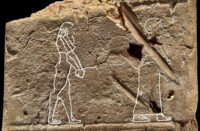 Well, the oldest known drawing of a ghost, at any rate, although who can say whether he haunts the tablet to this day. The fine line drawing incised on the back of a 3,500-year-old Babylonian tablet depicts a male ghost bound at the wrists and being led by a woman to the afterlife. It is an illustration of the cuneiform text on the obverse which explains how to get rid of a ghost who has attached himself to someone and won’t let go because he’s desperate for love.
Well, the oldest known drawing of a ghost, at any rate, although who can say whether he haunts the tablet to this day. The fine line drawing incised on the back of a 3,500-year-old Babylonian tablet depicts a male ghost bound at the wrists and being led by a woman to the afterlife. It is an illustration of the cuneiform text on the obverse which explains how to get rid of a ghost who has attached himself to someone and won’t let go because he’s desperate for love.
The tablet was acquired by the British Museum in the 19th century. Half of it is missing and the cuneiform was originally mistranslated, so it was deemed comparatively unremarkable and has never been exhibited. Nobody even noticed the figures on the back because they are so faint they can only be seen under bright light when viewed from directly above it. Enter the one, the only, the living legend, Dr. Irving Finkel.
Dr Irving Finkel, curator of the Middle Eastern department at the British Museum, said the “absolutely spectacular object from antiquity” had been overlooked until now.
“It’s obviously a male ghost and he’s miserable. You can imagine a tall, thin, bearded ghost hanging about the house did get on people’s nerves. The final analysis was that what this ghost needed was a lover,” he said.
“You can’t help but imagine what happened before. ‘Oh God, Uncle Henry’s back.’ Maybe Uncle Henry’s lost three wives. Something that everybody knew was that the way to get rid of the old bugger was to marry him off. It’s not fanciful to read this into it. It’s a kind of explicit message. There’s very high-quality writing there and immaculate draughtsmanship.
“That somebody thinks they can get rid of a ghost by giving them a bedfellow is quite comic.”
Finkel was the first to decipher it correctly and recognize it as a ghost magic text complete with visual aid on the reverse. The instructions explain how to “seizes hold of a person and pursues him and cannot be loosed.” Spoiler: dress a woman in red, equip her with a bed and he’ll fall right into the trap.
The ritual involves making figurines of a man and a woman: “You dress the man in an everyday shift and equip him with travel provisions. You wrap the woman in four red garments and clothe her in a purple cloth. You give her a golden brooch. You equip her fully with bed, chair, mat and towel; you give her a comb and a flask.
“At sunrise towards the sun you make the ritual arrangements and set up two carnelian vessels of beer. You set in place a special vessel and set up a juniper censer with juniper. You draw the curtain like that of the diviner. You [put] the figurines together with their equipment and place them in position… and say as follows, Shamash [god of the sun and judge of the underworld by night].”
The text ends with a warning: “Do not look behind you!”
As you may or may not recall, Finkel shared his gleeful appreciation of Babylonian ghost lore in a wonderful video I posted four years ago. (No word on whether he received all the chameleon bristles, frog claws and left wings of grasshoppers he needed to raise the dead according to the recipe on that tablet.) That enthusiastic embrace of ancient ghost-related ritual, not to mention Finkel’s vast intellect and witty writing style, are sure to be on full display in his forthcoming book on ancient Mesopotamian belief in ghosts. The First Ghosts: Most Ancient of Legacies is set for publication on November 11th but not yet available for pre-order anywhere (and yes, I checked). You can get your Finkel fix earlier than that at a British Museum webinar discussing the history of Assyrian ghostology on October 28th, the perfect amouse-bouche for a Halloween candy binge.